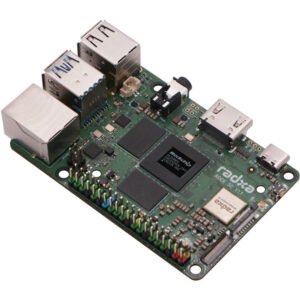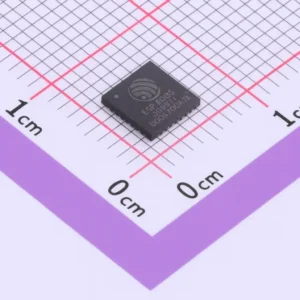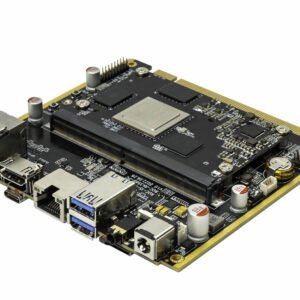ESP32-C6 ESPRESSIF ESP32-C6 Wi-Fi 6 IoT SoC – RISC-V, BLE 5.3, Zigbee/Thread
- Tri-radio in one chip: Wi-Fi 6 + Bluetooth LE 5.3 + 802.15.4 (Zigbee/Thread) with built-in coexistence on a single antenna.
- Secure by design: Secure boot, XTS-AES flash encryption, digital signature, RSA/ECC, and HMAC in hardware.
- Ultra-low power: Deep-sleep around 7 µA with LP-SRAM retention and Target Wake Time to extend battery life.
ESPRESSIF ESP32-C6 Overview, Specifications, and Applications for IoT
The ESPRESSIF ESP32-C6 is an ultra-low-power, highly integrated IoT SoC that brings 2.4 GHz Wi-Fi 6 (802.11ax), Bluetooth® Low Energy 5.3, and IEEE 802.15.4 support for Zigbee® 3.0 and Thread 1.3 into a single, compact device. Built around a dual-domain architecture with a high-performance 32-bit RISC-V core up to 160 MHz and a low-power 32-bit RISC-V core up to 20 MHz, ESP32-C6 is designed to deliver responsive, feature-rich edge devices while keeping power draw exceptionally low.
On the wireless side, the ESP32-C6 implements key Wi-Fi 6 features—OFDMA (uplink and downlink), downlink MU-MIMO, BSS Coloring, Target Wake Time (TWT), and MCS0–MCS9 with 20 MHz channel width—optimizing throughput and efficiency in dense networks. Bluetooth LE 5.3 adds long-range PHYs (125 kbps/500 kbps), 1 Mbps/2 Mbps modes, advertising extensions, LE power control, Bluetooth Mesh, and a high-power mode, while 802.15.4 enables standards-based low-power mesh applications with Zigbee and Thread.
Security is hardware-rooted with secure boot, flash and external memory encryption (XTS-AES), digital signature, HMAC, RSA/ECC, and SHA accelerators. For peripherals, ESP32-C6 provides a modern toolkit: SPI (incl. Dual/Quad/QPI) for external flash and devices, I²C, I²S, UART, TWAI® (CAN bus), RMT (remote control), LED PWM, MCPWM, PCNT, PARLIO (parallel I/O), GDMA, ETM (event–task matrix), and USB Serial/JTAG for development and device connectivity.
Analog resources include a 12-bit SAR ADC (up to 7 channels) and an on-chip temperature sensor. Memory comprises 512 KB HP-SRAM, 16 KB LP-SRAM, 320 KB ROM, and a flexible external flash interface; modules and on-package flash variants simplify design. With Deep-sleep current down to microamps, antenna diversity, and robust RF (+21 dBm 11b; up to +19.5 dBm 11ax), the ESP32-C6 fits everything from battery-powered sensors and smart home endpoints to gateways, wearables, and industrial nodes.
Common orderable series include ESP32-C6, ESP32-C6FH4, and ESP32-C6FH8 (the “FH” options integrate flash in the package), available in QFN40 (5×5 mm) with 30 GPIOs or QFN32 (5×5 mm) with 22 GPIOs—giving designers the choice of footprint and pin count to match their bill of materials and PCB constraints.
Specifications (two-column table)
| Parameter | Value |
|---|---|
| CPU (High-Performance) | 32-bit RISC-V, up to 160 MHz, 4-stage pipeline |
| CPU (Low-Power) | 32-bit RISC-V, up to 20 MHz, 2-stage pipeline |
| Wireless – Wi-Fi | 2.4 GHz 802.11ax (Wi-Fi 6); 20 MHz channel (non-AP mode); OFDMA (UL/DL), DL MU-MIMO, BSS Coloring, TWT, MCS0–MCS9, beamforming, CQI, DCM, 4 virtual interfaces; STA/AP/STA+AP/promiscuous; 802.11mc FTM |
| Wireless – Bluetooth LE | Bluetooth® 5.3 certified; 125 kbps/500 kbps/1 Mbps/2 Mbps; Advertising Extensions; LE Power Control; Bluetooth Mesh; internal Wi-Fi/BT coexistence; high-power mode |
| Wireless – 802.15.4 | IEEE 802.15.4-2015, 2.4 GHz OQPSK, 250 kbps; Zigbee 3.0 and Thread 1.3 |
| Antenna / RF | Integrated RF balun & switches; +21 dBm (802.11b) TX; up to +19.5 dBm (802.11ax) TX; BLE RX sensitivity down to −106 dBm (125 kbps); antenna diversity |
| Memory (On-chip) | 512 KB HP-SRAM, 16 KB LP-SRAM, 320 KB ROM |
| External Memory | SPI/Dual/Quad/QPI/QPI-flash; flash controller with cache; in-circuit programming (ICP) |
| On-package Flash Options | ESP32-C6FH4 / ESP32-C6FH8 variants with integrated flash |
| GPIO Count | 30 GPIOs (QFN40) or 22 GPIOs (QFN32); 5 strapping pins; typically 6 GPIOs used for off-package flash |
| ADC & Sensors | 12-bit SAR ADC, up to 7 channels; on-chip temperature sensor |
| Timers & Watchdogs | 52-bit system timer; two 54-bit general timers; digital watchdogs; analog watchdog |
| Communication Interfaces | SPI, I²C, I²S, UART, RMT, PARLIO, PCNT, TWAI® (CAN), SDIO 2.0 (Slave) |
| Control & PWM | LED PWM, MCPWM for motor control |
| DMA & Eventing | GDMA (3 TX / 3 RX channels); ETM (Event-Task Matrix) |
| USB | USB Serial/JTAG (built-in) for programming, logging, and debugging |
| Security | Secure Boot, Memory/Flash Encryption (XTS-AES), Digital Signature, HMAC, RSA/ECC, SHA; 4096-bit OTP with up to 1792-bit user area; TEE controller with access permissions |
| Power Modes | Active, Modem-sleep, Light-sleep, Deep-sleep |
| Deep-sleep | ~7 µA typical; LP memory retention in Deep-sleep |
| Operating Frequency | 2412–2484 MHz (Wi-Fi/BT/802.15.4) |
| Coexistence | Internal coexistence for Wi-Fi, BLE, and 802.15.4 sharing one antenna |
| Packages | QFN40 (5×5 mm) or QFN32 (5×5 mm) |
| Operating Temp | —40 °C to +105 °C (typical industrial range; see device/Module limits) |
| Development | ESP-IDF support; on-chip USB Serial/JTAG; comprehensive SDKs for Wi-Fi 6, BLE, Zigbee, Thread |
| Typical Use Cases | Smart Home, Industrial Automation, Healthcare, Consumer, Smart Agriculture, POS, Robotics, Audio, Low-power sensor hubs and data loggers |
Applications
Smart Home & Building
Create responsive, low-power devices—Thread and Zigbee sensors, smart locks, thermostats, lighting controllers, energy meters, and voice-assistant accessories—while leveraging Wi-Fi 6 for hub/backhaul connectivity and Bluetooth LE for provisioning.
Industrial & Commercial
Use TWAI (CAN) for fieldbus integration, MCPWM for motor/actuator control, and GDMA/ETM for deterministic data movement. Wi-Fi 6 features like OFDMA and TWT improve reliability and battery life in dense factory floors or retail spaces, while 802.15.4 enables scalable mesh telemetry.
Healthcare & Wearables
Combine Bluetooth LE for device pairing and short bursts of data with Wi-Fi for high-throughput uploads. Deep-sleep down to microamps and LP RISC-V background processing extend battery life for portable monitors or asset-tracking tags.
Smart Agriculture & Environmental Sensing
Pair rugged sensors to the 12-bit ADC and temperature sensor; send periodic reports via Thread, Zigbee, or Wi-Fi. TWT schedules extend the lifetime of solar-powered nodes in remote deployments.
Retail, Payments & POS
Implement secure, always-connected terminals leveraging hardware crypto, secure boot, and memory encryption. Multi-radio capability supports companion peripherals (BLE) and infrastructure connectivity (Wi-Fi).
Robotics, Audio & Consumer Electronics
Use I²S for audio pipelines, MCPWM for BLDC/servo drives, and RMT/PCNT for IR control and encoder feedback. Wi-Fi 6’s improved airtime efficiency and MU-MIMO keep devices responsive in crowded homes and classrooms.
Three quick highlights
-
Tri-radio in one chip: Wi-Fi 6 + Bluetooth LE 5.3 + 802.15.4 (Zigbee/Thread) with built-in coexistence on a single antenna.
-
Secure by design: Secure boot, XTS-AES flash encryption, digital signature, RSA/ECC, and HMAC in hardware.
-
Ultra-low power: Deep-sleep around 7 µA with LP-SRAM retention and Target Wake Time to extend battery life.
Why choose ESP32-C6 for your next design?
-
High network efficiency in dense environments. Wi-Fi 6 features—OFDMA, DL MU-MIMO, BSS Coloring, and TWT—provide predictable performance and reduced contention versus legacy Wi-Fi, ideal for multi-tenant buildings and smart-home clusters.
-
Flexible radio strategy. Mix and match Wi-Fi backhaul with Thread/Zigbee mesh at the edge, while Bluetooth LE streamlines commissioning and device-to-device interactions—no extra radios needed.
-
Developer-friendly. The ESP-IDF SDK, on-chip USB Serial/JTAG, and a large community enable fast bring-up, robust security updates, and long-term maintainability.
-
Rich peripherals for real-world designs. From TWAI (CAN) and MCPWM to I²S, RMT, PARLIO, and GDMA/ETM, ESP32-C6 can directly drive motors, sense analog signals, and handle time-critical I/O without heavy CPU load.
-
Right-sized hardware. Choose QFN40 (30 GPIOs) or QFN32 (22 GPIOs) packages, plus variants with on-package flash (ESP32-C6FH4/C6FH8) to simplify BOM and layout.
Design tips
-
Power budgeting: Combine TWT, Light-sleep, and Deep-sleep to schedule bursts of activity around sensor reads and radio airtime. Keep the HP core mostly idle and offload periodic tasks to the LP RISC-V domain.
-
RF layout: Follow Espressif’s reference designs for antenna matching and keepouts. Antenna diversity can help in challenging enclosures.
-
Secure provisioning: Use BLE LE or a temporary SoftAP to securely deliver credentials. Enable secure boot and flash encryption early in development to align production and factory flows.
-
Deterministic I/O: For precise timing (motors, LED dimming, IR), use MCPWM, LED PWM, RMT, and ETM instead of polling in firmware.
If you need a module form factor (antenna, RF tuning, and flash already integrated), consider ESP32-C6-based modules from Espressif to accelerate certification and time-to-market, or select ESP32-C6FHx on-package flash variants to reduce external memory routing.
Specification: ESPRESSIF ESP32-C6 Wi-Fi 6 IoT SoC – RISC-V, BLE 5.3, Zigbee/Thread
|







